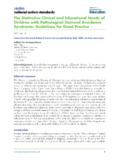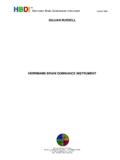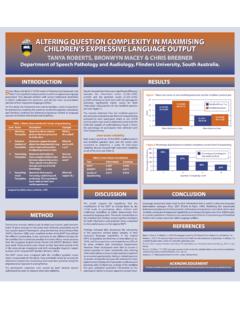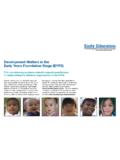Transcription of MODALITY: A PHENOMENOLOGICAL CONCEPT FOR …
1 MODALITY: A PHENOMENOLOGICAL CONCEPT FOR EXPRESSIVE ART THERAPIES Jacques Stitelmann PhD L'ATELIER 24, avenue du Mail 1205 Gen ve, Suisse - 2012 Translated by Jackie Beaver Summary This article goes more deeply into the CONCEPT of modality put forward by Paolo Knill as a key CONCEPT of expressive art therapy. A photograph of PK animating a workshop disturbs the author's mental image of who PK is, leading him to point out how enriching it is to be able to entertain different ideas at the same time. The CONCEPT of work is questioned and completed by that of working. The frequent confusion of mediality with modality is clarified, modality being a PHENOMENOLOGICAL CONCEPT that is specific to expressive art therapies.
2 Six modalities are presented and described, as is their utility in planning interventions, accompaniment and evaluating treatments. Experiencing Paolo Knill One day, after the last Spring Symposium in Lisbon, I found myself face to face with a photograph of Paolo Knill. In it, I saw him at work during a community art session and through it I discovered a person other than the Paolo Knill I remembered. (From now on I refer to Paolo Knill as PK.) I was astonished at the contrast between this photograph and how I picture the man. I felt a kind of shock, a questioning. Although a mental image is built up gradually though the accumulation of lived moments and is relatively stable over time, a photograph simply captures an instant, and sometimes quite unmercifully at that.
3 A photograph raises questions by underlining particular aspects of the subject, drawing our attention by setting them outside time and space. A photograph's effect, perhaps its main effect, has to do with what it does not show the not-showing of time and space beyond its edges and the feelings it cannot account for. And so, a photograph prompts us to use our creativity and our imagination to understand it and find a place for it in the flow of our existence. My mental image of PK, already complex, was essentially that of an active and dynamic man. I've often said to myself how much I would like to have his energy at 70, let alone when I am 80! His slim build doesn't give away his age! He emanates vitality at all times, playful creativity, childlike and unceasing.
4 In his workshops he leaps between participants' artistic successes and mess-ups with feline aplomb, snatches them up and in a flash, turns them into primary elements for a new expressive proposition, so furthering the creative flux. Teeth bared or full of fondness, his look evolves with every moment. Despite surgery, I know he cannot see well. Occasionally his Swiss-German accent is difficult to understand, so much so that workshop participants are obliged to exercise their freedom to interpret instructions that can sometimes be overly directive. My lived experience of this moment captured in a photograph had not altered the longstanding image I had of him. But now, this photograph showed an old man whose small eyes, though reddened and tired still sparkled with a loosely controlled grin, a dry and bony body, pursed lips drooping at the corners, whitened hair and wrinkled forehead, a vaguely bitter smile hinted at in profile, a piercing yet tender gaze.
5 A sensation of being overtaken by, and yet still surfing, the tide of events. Was this the same man? Of course I knew and felt it was. But what then? The photograph had taken me by surprise, it had shocked me, taken hold of me and thrown me off balance. It had left me feeling uncertain of myself and of what I knew, uncertain about the image of the PK I remembered. And yet, both images warranted attention; both images could exist alongside each other. It is a curious experience to have two different pictures of the same person; one through a staged event - that of PK leading a workshop, and the other through an image - a photograph that relates an event. Can different ways or modalities of apprehending the world, give us access to different aspects of reality?
6 Even though this photograph offers me an image of a man, associated ideas quickly emerge from my imagination, called up by the emptiness that surrounds the photograph itself. How can I honour this old man, this creative being, this friend? By writing about him? By feeling the creative breath blow through me? What will become of EGS when Paolo Knill and Steve Levine are too old? What do they want to do with it? What do they envisage? Can a creation, an institution live independently of its creators? How best to safeguard their creation which is also partly our own? By talking about it or by taking their research even further? I remember my feelings of attachment for another man, a childhood father figure, most of all the way he looked during the last few months of his life before sickness took him away.
7 A look that said what words could not; I'm getting weaker, Me, always a fighter and a winner, now I'm losing. But won't that happen to us all, aren't we all the same? A final childlike seeing acceptance of his own fragility, no more running away from it in thoughts and actions, like he used to when he was in full health. And for my father, who for this past year has hardly been able to walk, who thinks more slowly than before but with a perspective on events that makes you think he still has many years ahead of him. Every minute is lived with a fullness that but for a few fleeting instants, escapes us when we are young. A father from birth, a friend through life. The enjoyment I get from running my own training institute, like a community art project, adapting administrative and managerial thinking to human and interpersonal needs.
8 Profits, however real, can also be counted in terms of human achievement and cooperation and go well beyond any financial return. The idea that reality is multidimensional, that aspects of it have different forms depending on how they appear and the way we encounter them in the world. The thrill of letting different realities co-exist without reducing them to a single one; the pleasure of letting them drift on ahead, before pulling them together, not too tightly, making sense of life, of becoming, renewed, more sensitive and true. And the idea too, that if reality is multifaceted, then every person has freedom and responsibility to make choices, shape their destiny and give form to their personal truth.
9 Photography, like any other art form, questions the accepted order of things. First it sets you off balance. You accept the questions it raises and then you generate answers. You deploy your whole being in the very act of grappling with the questions. Some years ago, I commented on and developed PK's CONCEPT of crystallisation (Stitelmann 2003) and enhanced it with the CONCEPT of composting. Since it is one of PK's essential contributions to Art Therapy, I would like to look further into the often misunderstood CONCEPT of modality. PK's concepts of modality and inter-modality are central to Expressive Arts Therapy, along with his CONCEPT of work, which is closely linked to modality. Unfortunately, modality is often used as a synonym for mediality, which refers to particular media used for expression.
10 Sometimes the term is taken for art, in which expression is given form, or confused with sensations used to make connections with art works. Modality is a PHENOMENOLOGICAL CONCEPT that helps us think about the way we engage our attention when we encounter an art work, rather than telling us about the art work itself, or the psychological experience of its maker. Working through, work and working Traditional art therapy movements anchored in psychology, consider the products of creative processes, or art works, as products of a creator, and more specifically, of his/her psyche. The idea that unresolved aspects of psychological problems, unconsciously find a way to be expressed and even resolved through the artistic process, has been ardently put forward and verified time and time again.





